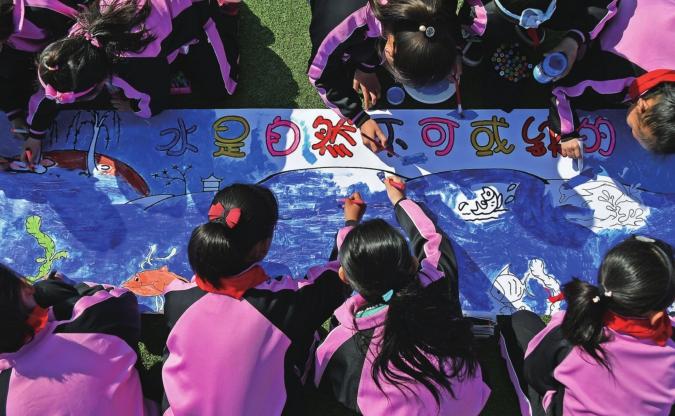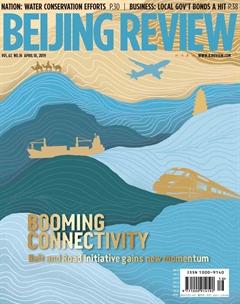Saving Every Drop
By Wang Hairong
By simply changing a water tap you can save 50 percent of water. This is a watersaving tip shared by Wei Shanzhong, Vice Minister of Water Resources, at a press conference held in Beijing to commemorate World Water Day on March 22.
“The structure of the faucet is not complicated. A simple device is added to it, so water released from the faucet is fi lled with air, creating bubbles. When you use the water, you feel the flow as almost the same, but in fact, it is much smaller. The amount of water fl owing out of the tap is less than half of the amount out of a regular tap during the same time period,” he explained.
Because of the bubbles, “when you wash your hands, you wont splash water on yourself or on the ground,” he added.
This water-saving faucet is being used at Hebei University of Engineering in Handan City, north Chinas Hebei Province, where a contract water-saving program is being piloted.
The program adopts a market-based water- saving model, said Xu Wenhai, Director of the National Water Conservation Offi ce. Under the program, enterprises and water-using organizations sign contracts where enterprises offer water-saving solutions to water users, recovering costs and making a profit by sharing the benefi ts from water saving.
“This is a multi-win model,” Xu said. For instance, universities can save water costs without directly investing any money, and hence it takes no financial risk; water-saving service enterprises can give full play to their technological and fi nancial advantages and cultivate new economic growth points; while at the same time, water resources can be saved, which is an important contribution to society.
Water scarcity
The contract water-saving program was piloted at the university because it is located in waterscarce north China, which includes Beijing and Tianjin municipalities, Hebei and Shanxi prov- inces as well as Inner Mongolia Autonomous Region.
Water resources are distributed unevenly in China, with more in the south and less in the north. North China is one of the areas where water shortage is most serious, especially in the Beijing, Tianjin and Hebei region.
“With a population of 168 million, north China has had only 4 percent of the countrys total water resources on average for many years,” Wei said.
In fact, China in general lacks fresh water.“China has managed to feed 20 percent of the worlds population with 6 percent the worlds freshwater resources and 9 percent of arable land,” said Yang Derui, Director of the Department of Water Resources Management of the Ministry of Water Resources.
In north China, to meet the growing water need from rapid agricultural and industrial development, a large amount of groundwater has been extracted since the 1970s, resulting in the reduction of surface water.
“Every year, about 5.5 billion cubic meters are extracted in north China, with 3.47 billion cubic meters drawn out of Beijing, Tianjin and Hebei,” Wei said.
Estimates showed that the accumulated total of groundwater overexploited in north China is about 180 billion cubic meters, affecting an 180,000-square km area, Wei said.“In some places, the groundwater level has dropped remarkably. Some areas have taken deep pressurized water and high fl uorine water, which can harm human health and the ecological environment,” Wei said.
In recent years, water-saving measures have been taken and the efficiency of water utilization has been improved.
“Compared to 2012, water consumption per 10,000 yuan ($1,490) of the GDP and industrial value added in 2017 decreased by 30 percent and 32.9 percent, respectively,” Wei said.
During this period, the effective utilization coefficient of farmland irrigation water increased from 0.516 to 0.548, he added.
Broad measures
The country has taken comprehensive measures to conserve water resources. For example, Wei said that in the agriculture sector, the crop planting structure has been adjusted and highefficiency water-saving irrigation has been promoted. In the industrial sphere, advanced technologies and equipment have been adopted to increase the reuse rate of industrial waste water and cut total water consumption. Urban water supply networks have been upgraded to reduce water leakage rates and household water-saving devices have been promoted.
According to Wei, water-saving programs have been implemented in public spaces, in government institutions and universities, and in water-consuming service industries. The use of unconventional water sources, such as rainwater and seawater has also been promoted.
Agriculture consumes the largest share of water, accounting for 62.3 percent of total water consumption in China in 2017. Meanwhile, the proportion of water consumed by industrial sector was 21.1 percent and domestic consumption was 13.9 percent, according to a report released by the Center for Forecasting Science of the Chinese Academy of Sciences in January.
He Zirong is a planter in Barunbieli Town, Alashan Left Banner, Alashan League of Inner Mongolia Autonomous Region. He has been using drip irrigation technology for large-scale millet cultivation for more than three years. He told Inner Mongolia Daily that after replacing the fl ood irrigation method with drip irrigation on the sandy land, irrigation water consumption has been nearly halved.
Chen Baofeng, head of the towns water service station said that excessive water use led to a signif icant decline in the groundwater level and the deterioration of water quality.
In order to change this situation, Barunbieli started to control total agricultural water use by allocating water use quota and distributing water rights to households, he said.
The town has also adjusted its planting structure and encourages the planting of water-saving crops such as lavender, rose, seed melon, Chinese medicinal herbs and millet. The planting area for high water-consuming crops has been reduced, while the high-quality forest and fruit industry as well as the leisure garden industry have been developed, farmland has been improved, and many electrical wells shut down, he said.
After two cattle breeding bases began construction in a neighboring town in 2017, the farmers in Barunbieli started to shift from planting silage maize to planting feed maize. This crop structural adjustment alone can save 2 million cubic meters of water annually, Chen said.
In addition to water saving in agriculture, there is great potential to save water and reduce waste water discharge in industries, Wei said.
He told the media that an enterprise located in an industrial park in Beijing is using recycled water in the production process of cellphone screens. “Not a single cubic meter of fresh water has been used. All of the water used is reclaimed, and nonetheless it is able to produce high-end products,” Wei said.
Using no fresh water in production is also the goal of SINOPEC SABIC Tianjin Petrochemical Co. Ltd. (SSTPC), a joint venture between the mega Chinese petrochemical company SINOPEC and the Saudi Arabian company SABIC.
According to the company, it has followed a sustainable development management concept since 2011 to meet the annual targets set by SABIC in terms of greenhouse gas emissions, energy and water consumption, and waste discharge.
To reduce the use of fresh water as much as possible, SSTPC uses treated municipal waste water and desalinated seawater. Large water storage tanks and water treatment facilities have been placed on the companys site to treat industrial waste water, domestic sewage and rainwater. The company slashed the proportion of fresh water used in production from 70 percent to 28 percent during the period of 2011-15.
Similar water-saving measures have been introduced into SINOPEC Shanghai Petrochemical Company. From 2017 to 2018, the share of recycled water used in the companys production process was increased from 20 percent to nearly 50 percent.
The effi ciency of water resource utilization in China has been continuously improving in recent years, Wei said, adding that currently, the national average effi ciency is close to the world average; yet there is still a considerable gap when compared to the worlds advanced level. He said that in the future, China will earnestly follow good water-saving practices and take comprehensive measures to resolutely curb the waste of water.

